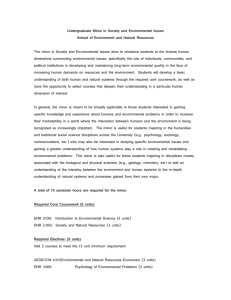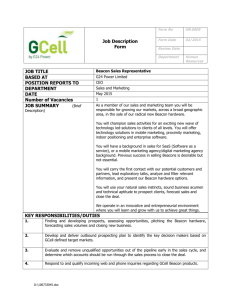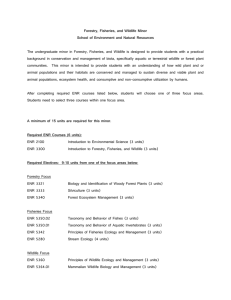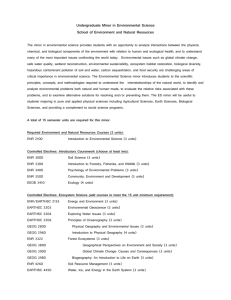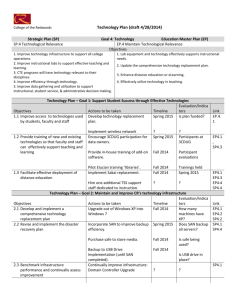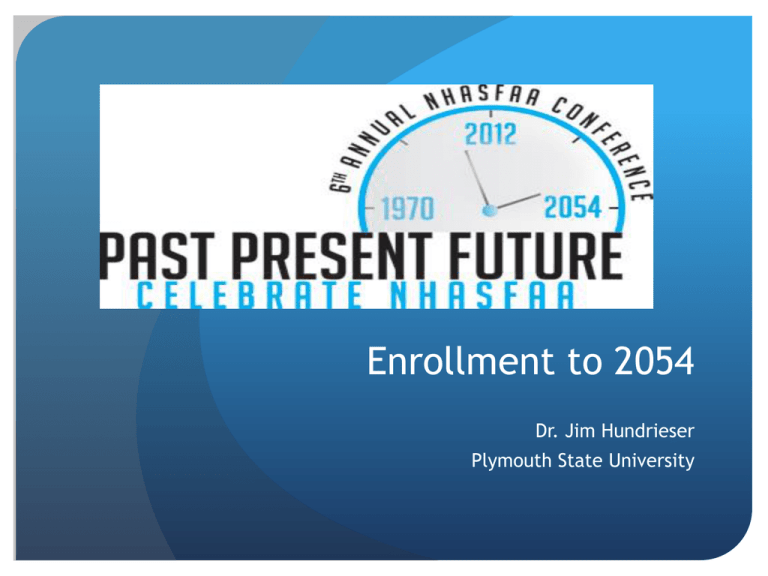
Enrollment to 2054
Dr. Jim Hundrieser
Plymouth State University
What is your desired future state?
Better
More
Cheaper
Student Enrollment
What is your desired future state?
Shape class
Increase new
student
Increase new
and graduate
more students
Current market
penetration
Competition
analysis
Demographics
Academic
offerings
Price sensitivity
Program delivery
styles
Co-Curricular
offerings
Goals:
Goals:
Goals:
Increase SAT/ACT to 1200
Increase first to second
year retention to 82%
Increase grad rate to 60%
Increase new student
class by 3% per year
Increase transfer class by
5% per year
Increase new students by
5% every other year
Increase second to third
year rate to 75%
© Noel-Levitz, Inc. All rights
Colleges were facing six major issues
in managing affordability
Rising college costs
Decreased
purchasing power
of federal aid
Increased
discounting
Declining
yield rates
Shifting
demographics
Increased
family
borrowing
What is the reality of higher education
Students’
ability to pay
Students’
willingness to
pay
Financial aid
strategy must
consist of two
criteria
Both elements must be present
for a student to enroll
What is the reality
facing higher education?
Students
aren’t
learning
We need to
increase
attainment
We need to
truly
educate
the 21st
century
student
Our
systems
must be
more
productive
and more
expanisive
Who is the 21st Century Student
Minority
Low
Income
Traditional
And
Some NonTrads
Traditional
Adult
First
Generation
To increase the proportion of
Americans with high-quality
degrees and credentials to 60
percent by the year 2025.
Future degree need predictions
Between 2008 and 2018, The U.S. economy will create
46.8 million job openings from new jobs and
retirement.
29.8 million of these job vacancies will be for those
with postsecondary credentials.
16 million will require a bachelors degree.
Only 17.9 million will be for high school
graduates and dropouts.
63% of job openings will require some postsecondary
training beyond high school by 2018.
Source: Help Wanted: Projections of Jobs and Education Requirements Through 2018
The Georgetown University Center on Education and the Workforce
Impact of the economic crisis on
student college planning
46% report that the current economic crisis has
caused them to reconsider the schools to which
they apply or may attend (up from 34% last year)
Avoiding private school options—26% (11%)
Commuting instead of living on campus—25% (13%)
Working while going to school—25% (21%)
Not attending college at all—1% (2%)
© 2010 Noel-Levitz, Inc.
E-Expectations Report: Focusing Your E-Recruitment Efforts to Meet the Expectations of College-Bound Students
And about half of all second year students
report college financing concerns
©2010, Noel-Levitz, Inc. All rights reserved
2010 Noel-Levitz Sophomore Survey
Average tuition, fee, room and board charges in constant 2010
dollars, 1980-81 to 2010-11
Private 4-yr.
Public 4-yr.
Public 2-yr.
$36,993
$35,000
$28,059
$30,000
$22,530
$25,000
$20,000
$15,000
$10,000
$5,000
$16,140
$14,747
$6,725
$1,031
$8,483
$1,515
$10,647
$2,072
$2,713
$0
1980-81
1990-91
2000-01
2010-11
Trends in College Pricing, 2010. © 2010. The College Board.
Reproduced with permission. www.collegeboard.com.
Average net revenue per student
(tuition, fees, room, and board)
$25,000
$20,000
$15,000
$10,000
$5,000
$0
2000 2001 2002 2003 2004 2005 2006 2007 2008 2009 2010
©2011 Noel-Levitz, Inc.
2011 Discounting Report
Copyright © 2010, Delta Project on Postsecondary Education Costs, Productivity, and Accountability.
Overall discount rates jumped for fall 2009 after
a decade of relative stability
40%
37.3%
38%
36.1%
36%
34%
32.3%
34.1%
33.7%
33.5%
33.4%
33.3%
33.1% 33.0%
32.8%
32%
30%
28%
26%
24%
2000
2001
2002
2003
2004
2005
2006
2007
2008
2009
2010
©2011 Noel-Levitz, Inc.
2011 Discounting Report
And the percentage of freshmen receiving
institutional grants is on the rise
86.0%
84.3%
84.0%
81.5%
82.0%
80.0%
78.0%
79.9%
81.1%
81.7%
82.3%
81.0%
79.9%
78.8%
77.8%
76.0%
74.0%
2000 2001 2002 2003 2004 2005 2006 2007 2008 2009
© 2010. NACUBO 2009 Tuition Discounting Study.
Reprinted with permission. This material may not be posted, published, or distributed without permission from NACUBO
Value of interactive Web features
Online application
50%
Campus visit request form
40%
Cost calculator
39%
Online course catalog
34%
RSS feeds
32%
31%
37%
29%
33%
32%
Site personalization
27%
32%
Virtual tours
26%
32%
0%
20%
Extreme value
40%
60%
80%
100%
A lot of value
© 2010 Noel-Levitz, Inc.
E-Expectations 2010: Focusing your E-Recruitment Efforts to Meet the Expectations of College-Bound Students
Net cost calculators have the potential to
dramatically shift the college cost conversation
% Completing a Scholarship Estimate
% Of Completes Requesting E-Mail w/Results
90%
80%
70%
60%
50%
40%
30%
20%
10%
0%
% Completing a Full Estimate
% Of Completes Requesting Follow-up Contact
77%
39%
12%
2%
% Taking this Action
Based on first 175,000+ contacts of Noel-Levitz published TrueCost Calculators™ – June 2011
Percentage of students satisfied or
very satisfied with their
overall experience
62%
61%
60%
58%
57%
56%
54%
54%
53%
52%
50%
48%
Four-year
privates
Four-year
publics
Community
colleges
Career schools
© 2011 Noel-Levitz, Inc.
2011 National Student Satisfaction and Priorities Report
Total Degrees
Table 1: Total fall enrollment in degree-granting institutions by type of institution: 1963 through 2009
Year and Type
Total Enr
4-Year Public
% of
Total Enr
2-Year Public
% of Total
Enr
4-Year Private
% of Total
Enr
2-Year
Private
% of
Total Enr
1963
4,779,609
2,341,468
49%
739,811
15%
1,587,780
33%
110,550
2%
1970
8,580,887
4,232,722
49%
2,195,412
26%
2,028,780
24%
123,973
1%
1980
12,096,895
5,128,612
42%
4,328,782
36%
2,441,996
20%
197,505
2%
1990
13,818,637
5,848,242
42%
4,996,475
36%
2,730,312
20%
243,608
2%
2000
15,312,289
6,055,398
40%
5,697,388
37%
3,308,460
22%
251,043
2%
2009
20,427,711
7,709,197
38%
7,101,445
35%
5,197,108
25%
419,961
2%
Growth %
327%
229%
860%
227%
280%
Compounded Annual
Growth Rate
3.2%
2.6%
5.0%
2.6%
2.9%
Total Enrollment
Table 1: Total fall enrollment in degree-granting institutions by type of institution: 1963 through 2009
Year and Type
Total Enr
4-Year Public
% of
Total Enr
2-Year Public
% of Total
Enr
4-Year Private
% of Total
Enr
2-Year
Private
% of
Total Enr
1963
4,779,609
2,341,468
49%
739,811
15%
1,587,780
33%
110,550
2%
1970
8,580,887
4,232,722
49%
2,195,412
26%
2,028,780
24%
123,973
1%
1980
12,096,895
5,128,612
42%
4,328,782
36%
2,441,996
20%
197,505
2%
1990
13,818,637
5,848,242
42%
4,996,475
36%
2,730,312
20%
243,608
2%
2000
15,312,289
6,055,398
40%
5,697,388
37%
3,308,460
22%
251,043
2%
2009
20,427,711
7,709,197
38%
7,101,445
35%
5,197,108
25%
419,961
2%
Growth %
327%
229%
860%
227%
280%
Compounded Annual
Growth Rate
3.2%
2.6%
5.0%
2.6%
2.9%
Graduation Rates over 20 Year
Table 10: Percentage four-year college students who earn a degree within five years of entry: 19902010 (in five-year increments)
1990
1995
2000
2005
2010
Public Institutions
47.9%
46.1%
41.9%
42.3%
43.4%
Private Institutions
57.8%
57.5%
55.5%
57.4%
57.2%
All Four-Year Institutions
54.9%
54.0%
51.2%
51.8%
52.3%
Six in ten college presidents say
the system of higher education in
this country is headed in the right
direction, but a substantial
minority (38%) say it is headed in
the wrong direction.
© Copyright 2011, Pew Research Center: Is College Worth It
Student Enrollment Funnel
Foundation of Practice
Competition, market demand,
and institutional strength
MARKET DEMAND:
What students want –
Relevance
COMPETITION:
Unoccupied market
positions – Differentiation
PROGRAM: What we do
best – Authenticity
A rubric for analyzing your student markets:
current state and future state (3-5 years out)
Student
Market
Cost of
Attendance
Institutional
Gift Aid
State/Feder
al
Gift Aid
External
Gift Aid
Net
Charges
First-Year
Transfers
Graduate
Students
Non-Degree
Student
Market
First-Year
Transfers
Graduate
Students
Non-Degree
Federal
Sub loans
Federal
Unsub.
loans
Parent
loans
Private
loans
Work
Student/
Family
Payment
Do you have a pricing and
positioning strategy?
•
What student markets do you currently serve and how do
they finance your cost of attendance?
•
How is their ability to finance your cost of attendance likely
to change over the next 3-5 years?
•
What strategies will you adopt to help your students
manage your cost of attendance?
Cost of Attendance or Net Charges
High cost, low selectivity
High cost, high selectivity
Selectivity/Dema
nd
Low cost, low selectivity
Low cost, high selectivity
Competitor analysis (lost admits)
Cost of Attendance or Net Charges
N=10
N=3
N=5
N=14
Selectivity/Demand
N=35
N=21
N=4
Execute on known fundamentals
• Package financial aid early to provide maximum time for
financial planning
• Make the financial aid award mirror the first bill
(estimated balance due, payment plan options with
amounts)
• Assess student award reaction and aggressively
intervene with families who want your institution, but are
having difficulty developing a financial strategy
• Communicate net cost of attendance early and often
(view the federal net price calculator requirement as an
opportunity)
Looking ahead to the 2054
Erosion of a flat-fee rate
Financial aid process more and more web-based
Our process will be more complicated; not less = Implications for
staff/staffing
Likely 10 to 15+ years before we really address cost, affordability,
and realities linked to degree completion
Financial aid leveraging moves us more and more away from fair/equal
and into yield based on market share
My Thanks to You!

